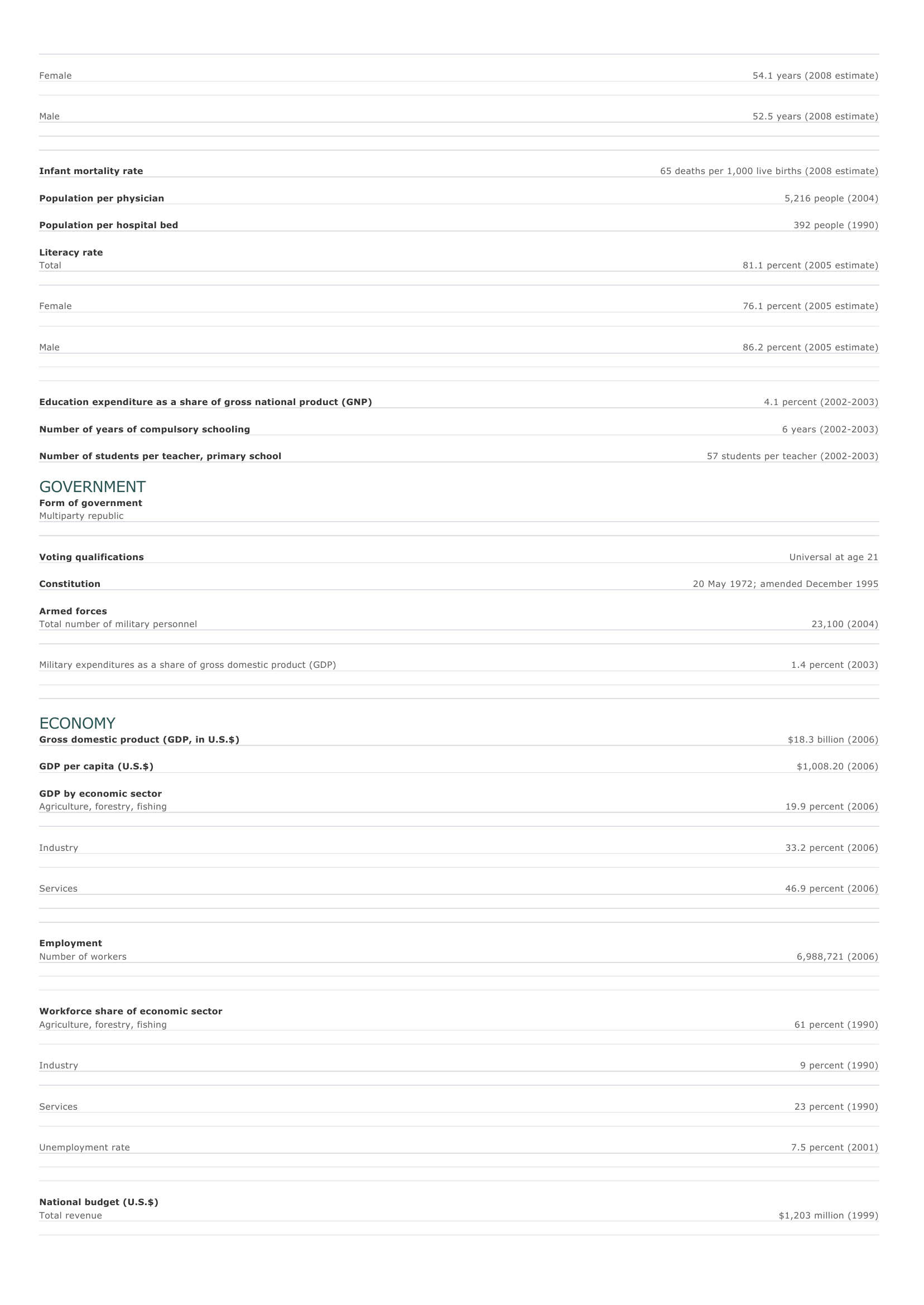Cameroon Facts and Figures. BASIC FACTS Official name Republic of Cameroon Capital Yaoundé Area 475,442 sq km 183,569 sq mi PEOPLE Population 18,467,692 (2008 estimate) Population growth Population growth rate 2.22 percent (2008 estimate) Projected population in 2025 25,522,447 (2025 estimate) Projected population in 2050 34,908,839 (2050 estimate) Population density 39 persons per sq km (2008 estimate) 102 persons per sq mi (2008 estimate) Urban/rural distribution Share urban 53 percent (2005 estimate) Share rural 47 percent (2005 estimate) Largest cities, with population Douala Yaoundé 1,494,700 (2001) 1,616,000 (2003 estimate) G aroua 160,000 (1992 estimate) Maroua 140,000 (1992 estimate) Nkongsamba 130,000 (1991 estimate) Bafoussam 120,000 (1992 estimate) Ethnic groups There are some 200 groups, the largest of which are the Fang, Bamileke, Fulani, and Pahouin (Beti). Most groups make up less than 1 percent of the population. Languages 24 major African language groups, English (official), French (official) Religious affiliations Roman Catholic 26 percent Indigenous beliefs 24 percent Muslim 21 percent Protestant 21 percent O ther 8 percent HEALTH AND EDUCATION Life expectancy Total 53.3 years (2008 estimate) Female 54.1 years (2008 estimate) Male 52.5 years (2008 estimate) Infant mortality rate Population per physician Population per hospital bed 65 deaths per 1,000 live births (2008 estimate) 5,216 people (2004) 392 people (1990) Literacy rate Total 81.1 percent (2005 estimate) Female 76.1 percent (2005 estimate) Male 86.2 percent (2005 estimate) Education expenditure as a share of gross national product (GNP) Number of years of compulsory schooling Number of students per teacher, primary school 4.1 percent (2002-2003) 6 years (2002-2003) 57 students per teacher (2002-2003) GOVERNMENT Form of government Multiparty republic Voting qualifications Constitution Universal at age 21 20 May 1972; amended December 1995 Armed forces Total number of military personnel Military expenditures as a share of gross domestic product (GDP) 23,100 (2004) 1.4 percent (2003) ECONOMY Gross domestic product (GDP, in U.S.$) GDP per capita (U.S.$) $18.3 billion (2006) $1,008.20 (2006) GDP by economic sector Agriculture, forestry, fishing 19.9 percent (2006) I ndustry 33.2 percent (2006) Services 46.9 percent (2006) Employment Number of workers 6,988,721 (2006) Workforce share of economic sector Agriculture, forestry, fishing 61 percent (1990) I ndustry 9 percent (1990) Services 23 percent (1990) Unemployment rate National budget (U.S.$) Total revenue 7.5 percent (2001) $1,203 million (1999) Total expenditure $1,409 million (1999) Monetary unit 1 Communaut* Financière Africaine (CFA) franc, consisting of 100 centimes Major trade partners for exports Spain, Italy, France, Netherlands, United States Major trade partners for imports France, Nigeria, United States, Germany, Japan ENERGY, COMMUNICATIONS, AND TRANSPORTATION Electricity production Electricity from thermal sources Electricity from hydroelectric sources 3.43 percent (2003 estimate) 96.57 percent (2003 estimate) Electricity from nuclear sources 0 percent (2003 estimate) Electricity from geothermal, solar, and wind sources 0 percent (2003 estimate) Number of radios per 1,000 people 163 (1997) Number of telephones per 1,000 people 6 (2004) Number of televisions per 1,000 people 33 (2000 estimate) Number of Internet hosts per 10,000 people Daily newspaper circulation per 1,000 people Number of motor vehicles per 1,000 people Paved road as a share of total roads 0.29 (2003) 7 (1996) 12 (1997) 10 percent (2004) SOURCES Basic Facts and People sections Area data are from the statistical bureaus of individual countries. Population, population growth rate, and population projections are from the United States Census Bureau, International Programs Center, International Data Base (IDB) (www.census.gov). Urban and rural population data are from the Food and Agriculture Organization (FAO) of the United Nations (UN), FAOSTAT database (www.fao.org). Largest cities population data and political divisions data are from the statistical bureaus of individual countries. Ethnic divisions and religion data are largely from the latest Central Intelligence Agency (CIA) World Factbook and from various country censuses and reports. Language data are largely from the Ethnologue, Languages of the World, Summer Institute of Linguistics International (www.sil.org). Health and Education section Life expectancy and infant mortality data are from the United States Census Bureau, International Programs Center, International database (IDB) (www.census.gov). Population per physician and population per hospital bed data are from the World Health Organization (WHO) (www.who.int). Education data are from the United Nations Educational, Scientific and Cultural Organization (UNESCO) database (www.unesco.org). Government section Government, independence, legislature, constitution, highest court, and voting qualifications data are largely from various government Web sites, the latest Europa World Yearbook, and the latest Central Intelligence Agency (CIA) World Factbook. The armed forces data is from Military Balance. Economy section Gross domestic product (GDP), GDP per capita, GDP by economic sectors, employment, and national budget data are from the World Bank database (www.worldbank.org). Monetary unit, agriculture, mining, manufacturing, exports, imports, and major trade partner information is from the statistical bureaus of individual countries, latest Europa World Yearbook, and various United Nations and International Monetary Fund (IMF) publications. Energy, Communication, and Transportation section Electricity information is from the Energy Information Administration (EIA) database (www.eia.doe.gov). Radio, telephone, television, and newspaper information is from the United Nations Educational, Scientific and Cultural Organization (UNESCO) database (www.unesco.org). Internet hosts, motor vehicles, and road data are from the World Bank database (www.worldbank.org). Note Figures may not total 100 percent due to rounding. Microsoft ® Encarta ® 2009. © 1993-2008 Microsoft Corporation. All rights reserved.








